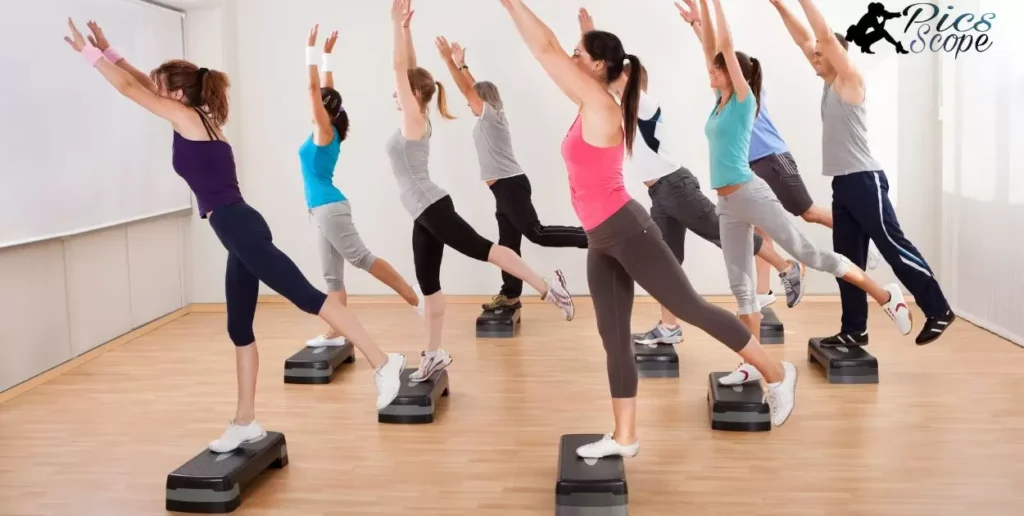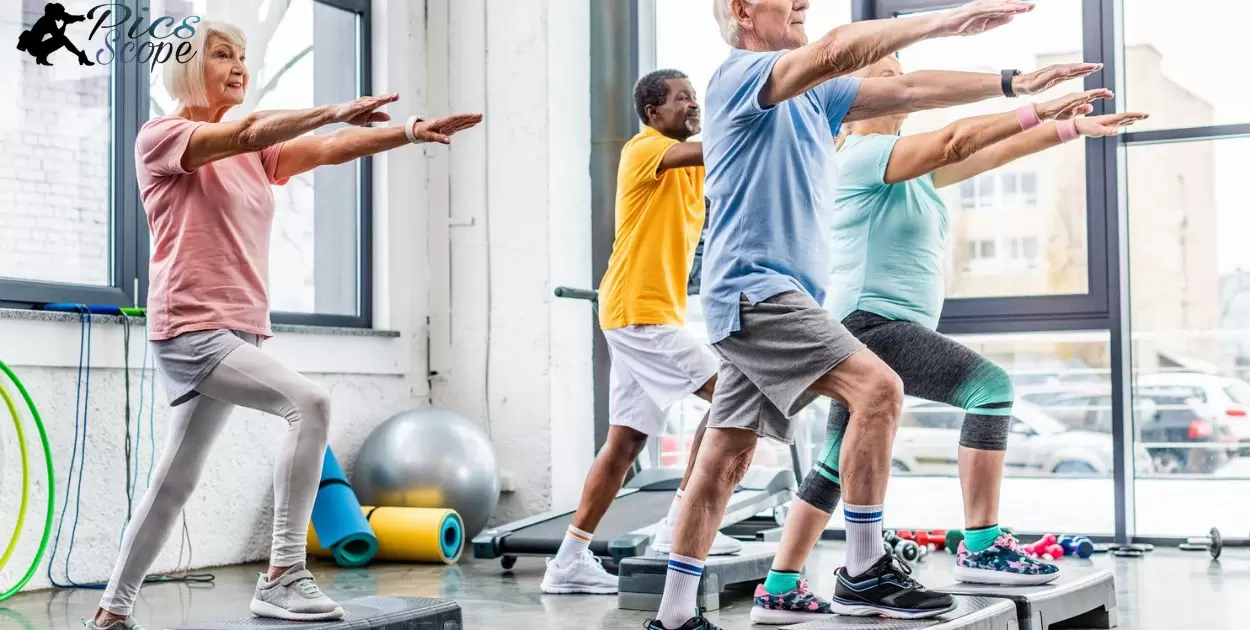Aerobic exercise benefits refer to the positive health effects of continuous, rhythmic exercise performed for a sustained period of time. Aerobic exercise makes our heart work harder by getting more oxygen and blood to your muscles. It also improves cardiovascular fitness and lowers health risks.
If you’re looking to boost your energy levels and reduce stress, “Aerobic Exercise Benefits” may be what you need. Participating in aerobic activities gets your heart pumping and blood circulating. Even light exercises like brisk walking or dancing can provide enough aerobic activation to leave you feeling rejuvenated.
Regular aerobic workouts have been shown to increase levels of HDL or “good” cholesterol while decreasing blood pressure and the risk of heart attack or stroke. Improved blood flow means more oxygen reaching your tissues, leaving you with greater endurance and alertness.
How Does Aerobic Exercise Improve Cardiovascular Health?
Aerobic exercise makes your heart work harder. When you do aerobics, your heart rate goes up. This is good for your heart. It helps your heart stay strong. Regular aerobic workouts can lower risks to your heart health. They may decrease blood pressure and bad cholesterol. They can also reduce the risk of heart disease and stroke.
Getting enough aerobic exercise builds up your cardiovascular fitness. Stronger heart and lungs can pump more oxygen through your body. This allows your heart to work more efficiently. Aerobic workouts can strengthen your heart muscle. Your heart does not have to work as hard to pump blood through your body.
What Mental Health Advantages Come from Aerobic Exercise?
Aerobic exercise fights stress and improves your mood. When you work out, your body releases feel-good hormones called endorphins. They make you feel more relaxed and happy. Aerobic exercise is also a great way to clear your mind. It gives you time to think and reduces stress.
Regular aerobic workouts may help those dealing with depression too. Physical activity influences brain chemistry in positive ways. It can boost serotonin and dopamine levels. These chemicals help your mood stay balanced. Aerobic workouts give your brain a boost and make you better able to handle stressors.
Can Aerobic Exercise Help With Weight Management?
Aerobic exercise burns a lot of calories which helps manage your weight. Different activities burn different amounts. Running will burn more calories than walking. The longer and harder you exercise, the more calories you lose. Aerobic workouts also build muscle which raises your metabolism.
Adding aerobic exercise to your routine makes it easier to maintain a healthy weight. Or if you need to lose pounds, it can help you do so safely. Regular aerobic workouts may even reduce belly fat which poses the most risk. Combined with smart nutrition, aerobics is a key to weight control.
How Might Aerobic Exercise Benefit Those With Diabetes?
Aerobic exercise is very important for those with diabetes. It helps your body use sugar better. Exercise makes your cells more sensitive to insulin. This keeps your blood sugar well balanced. Aerobic workouts reduce risks for diabetes too.
Keeping active also makes diabetes easier to manage. Physical activity prevents spikes and crashes in blood sugar levels. Aerobic exercise can improve HbA1c levels over time. For those with type 2 diabetes, working out regularly may even reduce needs for medication. Staying active is a key part of diabetes treatment.
Why Is Aerobic Fitness Important for Seniors?
As you age, aerobic fitness is important for health. It keeps seniors mobile and able to stay independent. Strong cardiovascular health helps seniors live active, enjoyable lives. Exercise reduces risks of falls which can greatly limit activity in later years.
Aerobic workouts also help keep seniors’ brains sharp. It may reduce risks for memory loss and even slow progression of dementia. Regular activity supports mental processing and social engagement important for well-being. Exercise keeps blood flowing freely to deliver nutrients seniors need throughout the body.
Which Aerobic Exercises Are Best for Building Endurance?
Running is among the best aerobic exercises to build a base of endurance. Other great options include swimming, cycling, rowing, and walking. All get your heart pumping if done continuously for 30 minutes or more. Group exercise classes like step aerobics or Zumba also raise your heart rate for an aerobic challenge.
Activities like hiking or playing tennis offer full-body workouts too while building endurance over longer duration. Choose options you enjoy to ensure you keep doing them regularly. Variety also helps prevent boredom and injury which could derail endurance goals. Listen to your body and progress gradually to see improvements.
How Much Aerobic Exercise Provides Optimal Benefits?
Most experts agree that 150 minutes per week of aerobic exercise provides significant health benefits. You can either do one longer session or spread time out in shorter sessions. For even more benefit, aim for 300 minutes per week of moderate aerobic activity.
You should work out hard enough to raise your heart rate and break a sweat. As a guide, try to work at a level where you could still talk but not sing. And strength training just twice a week complements aerobic exercise well for optimal fitness results. Don’t forget to gradually build up for best results.
Does Aerobic Exercise Also Strengthen Your Bones?

Yes, regular aerobic activity can absolutely strengthen your bones and reduce risks of osteoporosis. Weight-bearing aerobics like walking and dancing place stress on bones that signals them to get stronger. Even non-weight bearing exercise like swimming is good because it keeps bones load-bearing muscles fit.
High impact exercise provides the best bone benefit by forcing bones to work against gravity. Jogging and aerobic dancing provide pounding stress training for bones. Combined with sufficient calcium intake from food, regular aerobics reduces risks for fractures and supports bone health throughout life.
Where Can You Do Aerobic Exercises?
Luckily, there are many options to fit aerobic activity into your lifestyle. You can invest in home workout equipment or take live-streamed classes in your own space. Many local gyms offer an array of aerobic machines and classes too. Outdoor options like running, hiking, biking are free.
Parks provide great places for exercises. You can even turn chores like mowing or gardening into aerobic sessions. Malls can provide a place to walk when weather’s bad. And don’t forget incidental aerobic activity from active hobbies like dancing or recreational sports. Choose enjoyable options to sustain a routine.
What Equipment Is Needed for Aerobic Training?
For basic aerobic activity, you need supportive shoes and workout clothes. Many activities require nothing else to get started and see benefits. Items like yoga mats and light hand weights add variety. For home workouts, inexpensive items like jump ropes deliver excellent cardio challenges too.
Invest in quality shoes appropriate for your activities to avoid injury. Other gear depends on your preferred routines. Equipment like treadmills, stationary bikes, and rowers offer convenience. Accessories monitor your workouts’ benefits. Simple options let you enjoy aerobics without busting your budget. Layer clothing to stay comfortable in any conditions too.
Does Aerobic Exercise Improve Flexibility Too?
When you do aerobic exercise, you use all your major muscle groups. This keeps your whole body flexible. The movement in aerobic workouts improves your range of motion. It helps you stretch more fully without strain. Activities like dancing or yoga provide especially good flexibility benefits alongside cardiovascular impact.
Flexibility is important for aerobic activities. Stretching allows you to exercise with better form and efficiency. Making flexibility part of your warmups and cooldowns enhances aerobic training. It prepares and recovers your body for optimal workouts over the long run. Taking the time to stretch makes exercise more enjoyable while improving overall fitness.
Is Too Much Aerobic Exercise Counterproductive?
Doing very intense aerobic workouts days in a row without rest can be counterproductive. It risks overtraining and risking injuries like stress fractures. Your body needs recovery time to adapt to new stresses. Taking a complete rest day between intense sessions lets your body heal.
If you ever feel unusually sore or in pain during a workout, it’s a sign to dial it back. Listen to what your body is telling you. Taking an extra rest day when really tired can prevent hit to your motivation. Balance is key to continued progress in your aerobic activity.
Can People With Disabilities Gain from Aerobic Exercise?
Yes, people with disabilities can often greatly benefit from adapted aerobic exercise. It strengthens heart and lungs while adjusting to individual capacity. Gyms offer machines accommodating specific needs. Sports like bocce, cycling, swimming allow modified involvement.
Community programs help make exercise accessible and social. Advancements in rehab and assistive technology further exercise options. Even limited mobility activities like wheelchair exercises provide overall health boost. Those able find new independence through adapted workout routines.
Do the Rewards of Aerobic Exercise Outweigh the Risks?
When done moderately and under medical supervision where needed, most evidence confirms aerobic exercise rewards far outweigh minimal risks. Even light activity of 30 minutes daily offers huge protection for heart, mental health, and more. Risks like injury are often lifestyle issues rather than inherent to safe exercise.
Rewards include reduced risks for chronic diseases while improving well-being. Aerobic fitness at any age supports living fuller, happier lives. While injury is possible, risks are small with gradual acclimation to safe activity levels. For overall health, experts agree aerobic benefits clearly overshadow minimal risks.
How Can Aerobic Exercise Promote Other Healthy Habits?

Aerobic exercise gives you more energy and motivation to maintain a balanced lifestyle. Being active makes healthy eating seem more important to fuel workouts. You’ll feel compelled to rest properly between sessions too. Daily activity routines make sedentary habits harder to justify.
Setting exercise goals encourages forming balanced habits together. Planning nutritious pre- and post-workout meals supports progress. Building stress management activities like yoga into your schedule makes maintaining focus on well-being easier. Habit stacking streamlines forming lifestyle best supporting wellness.
What Tips Make Aerobic Routines More Enjoyable?
Find activities you truly enjoy, like dancing, kickboxing or hiking for more fun. Invite family or friends so it’s social. Listening to engaging playlists or podcasts prevents boredom. Setting small, achievable challenges like increasing duration keeps you motivated. Reward progression to stay excited.
Switch activities to prevent burnout. Natural environments provide mental breaks. Tracking success inspires continued efforts. Celebrations maintain enthusiasm for routine. Having alternate plans if weather intervenes reduces excuses. Making exercise a priority, yet avoiding guilt on rare rest days preserves positivity.
Does Aerobic Fitness Impact Self-Image and Confidence?
Seeing your fitness and health improve through aerobic habits often boosts self-esteem. Accomplishing goals and feeling your body operate more efficiently inspires confidence. Looking and feeling stronger allows embracing an active lifestyle. Noticing your resilience and endurance increase can counter self-doubts.
Appreciating what your body can achieve through exercise encourages positive self-talk. Aerobic activity reduces stress, depression and cortisol, thereby encouraging self-acceptance. You feel empowered taking charge of wellness with support networks. It provides reassurance navigating life’s demands ability to handle challenges.
How Do High Intensity Interval Workouts Compare?
While continuous moderate exercise brings benefits, high intensity interval training (selling stock photography) (HIIT) delivers results more quickly for time-crunched schedules. brief bursts of maximum exertion raise heart rate faster alongside recovery periods. HIIT workouts have shown comparable benefits to longer, lower intensity exercise.
These workouts are challenging but effective when done just 3 times a week for 20 minutes. Research confirms HIIT improves heart health and metabolism. It effectively manages weight and blood sugar. Include a warmup, stretch when finished for balancing benefits. Start slowly to acclimate safely to interval routines
Which Populations Especially Benefit from Aerobics?
All age groups benefit from regular aerobic activity. However, children and teens see improved academic success and health. Seniors gain independence and a reduced risk for dementia. Those recovering from injury find exercises safe to regain mobility. Aerobic workouts support chronic conditions like heart disease, diabetes, cancer recovery too.
Expecting mothers can safely continue mild exercise to decrease risks later. Activity combats depression across all demographics. Refugees and stressed groups find community and relief through fitness classes as well. Aerobic exercise provides wide-reaching prevention and treatment services within mental and physical healthcare.
What Are Some Examples of Aerobic Exercise Routines?
Common routines include:
- 30 min walks or jogs 3x weekly
- Water aerobics classes 2x weekly
- Dancing workouts to upbeat playlists daily
- Interval training with jogging and jumping jacks
- Cycling 15 miles on weekend days
- Tennis or basketball games with friends weekly
- Hiking nature trails on weekends
- Stationary bike use while watching TV 30 mins daily
- Jumping rope or running stairs for 20 minutes, 3x weekly
- Variety makes routines enjoyable. Mix high and low impact. Try group classes and solo workouts. The key is finding the right match of activities and schedule to achieve weekly aerobic minutes and fitness goals.
FAQ’s
How does aerobic exercise benefit the body?
Aerobic exercise enhances cardiovascular health, improves lung capacity, and boosts overall endurance.
What is the most important aerobic exercise and why?
Running is often considered a crucial aerobic exercise as it engages multiple muscle groups, elevates heart rate, and promotes effective calorie burning.
Does aerobic exercise burn fat?
Yes, aerobic exercise, especially activities like jogging or cycling, promotes fat burning by increasing the body’s metabolic rate.
Should you do aerobics every day?
While regular aerobic exercise is beneficial, it’s essential to incorporate rest days to prevent overtraining and allow the body to recover and adapt.
Conclusion
Aerobic exercise has many proven health benefits. Regular aerobic activity can improve cardiorespiratory fitness and help manage body weight. It has also been shown to reduce the risk of heart disease, some cancers, diabetes and stroke. Engaging in activities like walking, swimming or cycling for at least 30 minutes most days of the week delivers optimal results.
Making aerobic exercise part of a weekly routine can significantly boost overall health and well-being. The cardiovascular and metabolic benefits are extensive, helping individuals to feel energized while lowering disease risk. Moderat intensity aerobic workouts are accessible for most people and require minimal equipment, creating a low-barrier way to support lifelong health.







